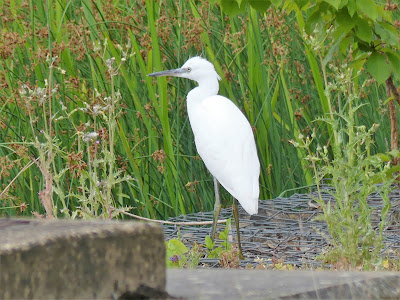Whilst on a lunchtime walk this week, Andy M spotted several Black-tailed Skimmers resting on the edge of the lake, as well as Common-Blue Damselfly and many Ringlet butterflies in the meadow near the sluice. Finally, at the river's edge an adult Grey Wagtail was seen feeding a fledged youngster. The young Grey Herons have now left the nest (photograph from 14th May).
Sightings and news for the Naturewatch group of Great and Little Abington in Cambridgeshire, UK. See below for more details and information on how to join.
Tuesday, 27 June 2017
More Granta Park Wildlife
Whilst on a lunchtime walk this week, Andy M spotted several Black-tailed Skimmers resting on the edge of the lake, as well as Common-Blue Damselfly and many Ringlet butterflies in the meadow near the sluice. Finally, at the river's edge an adult Grey Wagtail was seen feeding a fledged youngster. The young Grey Herons have now left the nest (photograph from 14th May).
Sunday, 25 June 2017
Granta Park wildlife
Friday, 23 June 2017
Butterflies
This is Jennifer's picture of a Small Tortoiseshell (22nd June):
Peter saw lots of small dark butterflies on the former LSA and in Granta Park (Sluice Wood) on 22 June. This is one such, apparently a Ringlet:
Thursday, 15 June 2017
End of May Bank Holiday Weekend Bird Survey
|
Blackbird
|
Great Spotted Woodpecker
|
Pheasant
|
|
Blackcap
|
Great tit
|
Pied Wagtail
|
|
Blue tit
|
Greenfinch
|
Reed Bunting
|
|
Bullfinch
|
Green Woodpecker
|
Red-legged partridge
|
|
Buzzard
|
Grey Heron
|
Robin
|
|
Canada Goose
|
Herring Gull
|
Rook
|
|
Carrion crow
|
House sparrow
|
Skylark
|
|
Chaffinch
|
House Martin
|
Song thrush
|
|
Chiffchaff
|
Jackdaw
|
Starling
|
|
Coal tit
|
Jay
|
Stock dove
|
|
Collared dove
|
Long-tailed tit
|
Swallow
|
|
Corn bunting
|
Magpie)
|
Swift
|
|
Dunnock
|
Moorhen
|
Whitethroat
|
|
Goldcrest
|
Mallard
|
Woodpigeon
|
|
Goldfinch
|
Mute Swan
|
Wren
|
|
Great Crested Grebe
|
Nuthatch
|
Yellowhammer
|
Sunday, 4 June 2017
Blackbirds nesting on High Street
On 10th June, they were looking healthy and hungry, and getting their feathers:
On 13th June, they look almost ready to fly the nest!
George reported that they all flew the nest some time on the afternoon of 14th June. He did not see them leave as he was too busy but, when he went to check early that evening, there was just an empty nest.
Trip to Lakenheath Fen 3rd June
www.rspb.org.uk/reserves-and-events/find-a-reserve/reserves-a-z/reserves-by-name/l/lakenheathfen/about.aspx
A good group (17 people) met at 10:00; we had an introductory talk by an RSPB Volunteer when we arrived. We walked along a well maintained path, stopping to eat our packed lunches at the west end of the public area. We then returned to the car park, most of us following the river back, about 3.5 miles walk in all.
There is a good walk through a varied wetland habitat, mostly reeds and grazing marshes, with some poplars, the remains of a Bryant and May matchwood plantation. The railway forms the south boundary and the river the north.
We saw a good number of birds, insects and flowers, including 43 species of birds:
|
Bittern
|
Great Tit
|
Oystercatcher
|
|
Black-headed Gull
|
Greenfinch
|
Pheasant
|
|
Blackbird
|
Grey Heron
|
Redshank
|
|
Buzzard
|
Greylag Goose
|
Reed Bunting
|
|
Carrion Crow
|
Hobby
|
Reed Warbler
|
|
Cetti's Warbler
|
Jay
|
Robin
|
|
Chaffinch
|
Kestrel
|
Rook
|
|
Chiffchaff
|
Lapwing
|
Sedge Warbler
|
|
Common Tern
|
Little Egret
|
Stonechat
|
|
Coot
|
Long-tailed Tit
|
Tufted Duck
|
|
Cormorant
|
Magpie
|
Whitethroat
|
|
Cuckoo
|
Mallard
|
Woodpigeon
|
|
Gadwall
|
Marsh Harrier
|
Wren
|
|
Goldfinch
|
Moorhen
|
|
|
Great Crested Grebe
|
Mute Swan
|
|
Andy took these photos:
 |
| Male and Female Four-spotted Chaser Dragonflies |
 |
| Drinker moth caterpillar |
 |
| Cinnabar moth |
 |
| Painted Lady |
 |
| Common blue damselfly |
 |
| Four-spotted Hawker |
 |
| Four-spotted Hawker |
 |
| Reed Bunting |
 |
| Reed Bunting |
 |
| Four-spotted Hawker |
and a couple of Peter's
 |
| Tortoiseshell |
 |
| Common blue damselfly |
The Aims of Abington Naturewatch
At their meeting on 9 April 2005 the members approved this revised version of the aims of Abington Naturewatch:
- To monitor and record the wildlife (fauna & flora) within the borders of the Abingtons;
- To encourage protection of our wildlife, maintain its quality and foster its diversity;
- To promote awareness of the richness, potential and problems of the natural environment of the Abingtons;
- To cooperate in improving access to the local natural environment for the benefit of all Abington villagers.
The organisation is informal and communication is by email if possible; members are notified of events from time to time. Contact details are maintained by a small "project team". There is currently no membership fee as costs are covered by voluntary contributions at events.
Members are encouraged to report notable sightings of flora and fauna within the Abingtons to the appropriate sector coordinator and an illustrated record is published annually.
A map of the area covered, with some features noted, is available here: http://maps.google.co.uk/maps/ms?ie=UTF8&hl=en&msa=0&msid=213774935674882866424.00000111dca2be9f06ab8&z=13>
For more information or to join, please contact David Farrant on (01223) 892871.
Contributions to our records should be sent to sector contacts or either of the above. Photographs may also be submitted to Andy Merryweather (amerryweather61@gmail.com)























